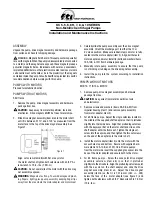
6.4.4 Bearings inspection
Condition of bearings
Do not reuse bearings. The condition of the bearings provides useful information on operating conditions
in the bearing frame.
Checklist
Perform these checks when you inspect the bearings:
•
Inspect the ball bearings for contamination and damage.
•
Note any lubricant condition and residue.
•
Inspect the ball bearings to see if they are loose, rough, or noisy when you rotate them.
•
Inspect the silicon carbide bearings for cracks, chips, or excessive wear. If any of these conditions
exist, replace the bearing cartridge.
•
Investigate any bearing damage to determine the cause. If the cause is not normal wear, correct
the issue before you return the pump to service.
6.4.5 Minimum running clearances
This table provides the radial wear ring clearances:
Group
Size
New, mm | inches
Replace, mm | inches
S
1 x 1½ - 6
1 x 1½ - 6G
1½ x 3 - 6
2 x 3 - 6
1 x 1½ - 8
1 x 1½ - 8H
1½ x 3 - 8
2 x 3 - 8
0.51–0.61 | 0.020–0.024
0.74 | 0.029
M
1½ x 3 - 10
3 x 4 - 7
4 x 4 - 8G
3 x 4 - 10
1 x 2 - 10
2 x 3 - 10
1½ x 3 - 13
0.71–0.79 | 0.028–0.031
0.91 | 0.036
6.5 Reassembly
6.5.1 Reassemble the frame assembly and shaft (frame-mounted pumps)
1.
Press both radial ball bearings (112) onto the drive shaft (122B).
NOTICE:
There are several methods you can use to install bearings. The recommended method is to
use an induction heater that heats and demagnetizes the bearings.
6.5 Reassembly
Model 3296 EZMAG Installation, Operation, and Maintenance Manual
67
















































